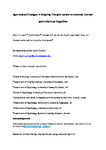Age-related changes in ongoing thought relate to external context and individual cognition
| dc.contributor.author | Turnbull, A | |
| dc.contributor.author | Poerio, GL | |
| dc.contributor.author | Ho, Nerissa | |
| dc.contributor.author | Martinon, LM | |
| dc.contributor.author | Riby, LM | |
| dc.contributor.author | Lin, FV | |
| dc.contributor.author | Jefferies, E | |
| dc.contributor.author | Smallwood, J | |
| dc.date.accessioned | 2022-02-08T12:31:46Z | |
| dc.date.issued | 2021-11 | |
| dc.identifier.issn | 1053-8100 | |
| dc.identifier.issn | 1090-2376 | |
| dc.identifier.other | 103226 | |
| dc.identifier.uri | http://hdl.handle.net/10026.1/18678 | |
| dc.description.abstract |
Understanding how age-related changes in cognition manifest in the real world is an important goal. One means of capturing these changes involves "experience sampling" participant's self-reported thoughts. Research has shown age-related changes in ongoing thought: e.g., older adults have fewer thoughts unrelated to the here-and-now. However, it is currently unclear how these changes reflect cognitive aging or lifestyle changes. 78 younger adults and 35 older adults rated their thought contents along 20 dimensions and the difficulty of their current activity in their daily lives. They also performed cognitive tasks in the laboratory. In a set of exploratory analyses, we found that older adults spent more time thinking positive, wanted thoughts, particularly in demanding contexts, and less time mind wandering about their future selves. Past-related thought related to episodic memory differently in older and younger adults. These findings inform the use of experience sampling to understand cognitive aging. | |
| dc.format.extent | 103226-103226 | |
| dc.format.medium | Print-Electronic | |
| dc.language | en | |
| dc.language.iso | en | |
| dc.publisher | Elsevier BV | |
| dc.subject | Mind wandering | |
| dc.subject | Ongoing thought | |
| dc.subject | Aging | |
| dc.subject | Everyday cognition | |
| dc.title | Age-related changes in ongoing thought relate to external context and individual cognition | |
| dc.type | journal-article | |
| dc.type | Journal Article | |
| dc.type | Research Support, Non-U.S. Gov't | |
| plymouth.author-url | https://www.webofscience.com/api/gateway?GWVersion=2&SrcApp=PARTNER_APP&SrcAuth=LinksAMR&KeyUT=WOS:000711973500006&DestLinkType=FullRecord&DestApp=ALL_WOS&UsrCustomerID=11bb513d99f797142bcfeffcc58ea008 | |
| plymouth.volume | 96 | |
| plymouth.publication-status | Published | |
| plymouth.journal | Consciousness and Cognition | |
| dc.identifier.doi | 10.1016/j.concog.2021.103226 | |
| plymouth.organisational-group | /Plymouth | |
| plymouth.organisational-group | /Plymouth/Faculty of Health | |
| plymouth.organisational-group | /Plymouth/Faculty of Health/School of Psychology | |
| plymouth.organisational-group | /Plymouth/REF 2021 Researchers by UoA | |
| plymouth.organisational-group | /Plymouth/REF 2021 Researchers by UoA/UoA04 Psychology, Psychiatry and Neuroscience | |
| plymouth.organisational-group | /Plymouth/REF 2021 Researchers by UoA/UoA04 Psychology, Psychiatry and Neuroscience/UoA04 Psychology, Psychiatry and Neuroscience MANUAL | |
| plymouth.organisational-group | /Plymouth/Users by role | |
| plymouth.organisational-group | /Plymouth/Users by role/Academics | |
| dc.publisher.place | United States | |
| dcterms.dateAccepted | 2021-10-10 | |
| dc.rights.embargodate | 2022-10-21 | |
| dc.identifier.eissn | 1090-2376 | |
| dc.rights.embargoperiod | Not known | |
| rioxxterms.versionofrecord | 10.1016/j.concog.2021.103226 | |
| rioxxterms.licenseref.uri | http://www.rioxx.net/licenses/all-rights-reserved | |
| rioxxterms.licenseref.startdate | 2021-11 | |
| rioxxterms.type | Journal Article/Review |


